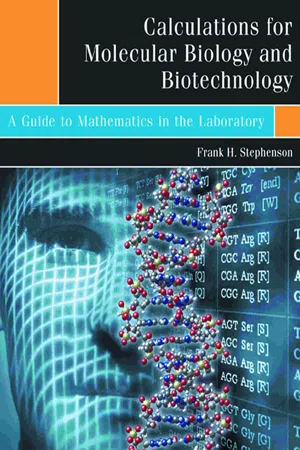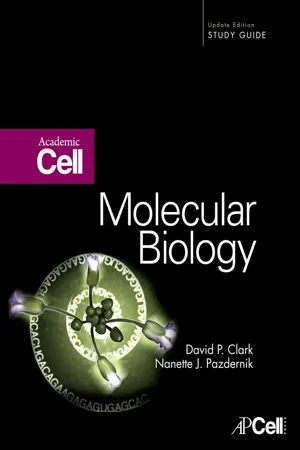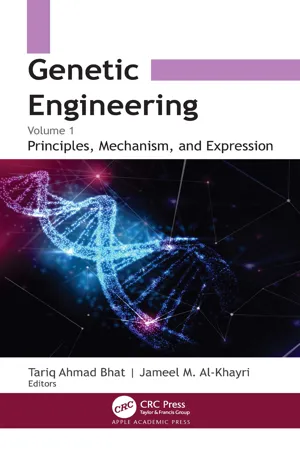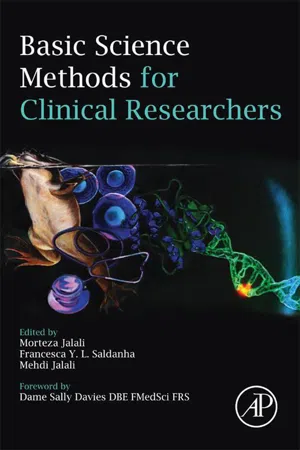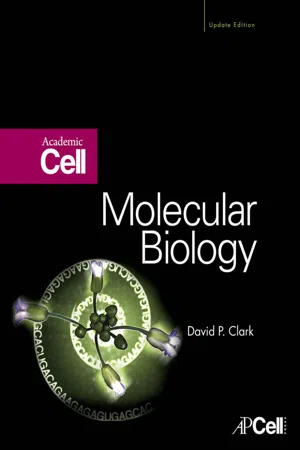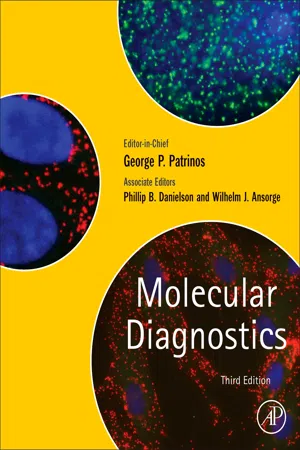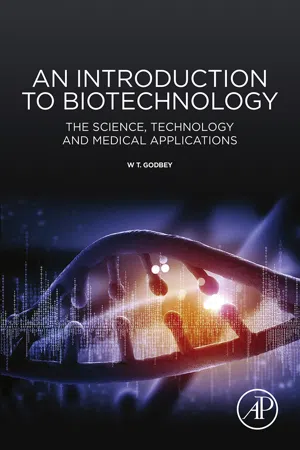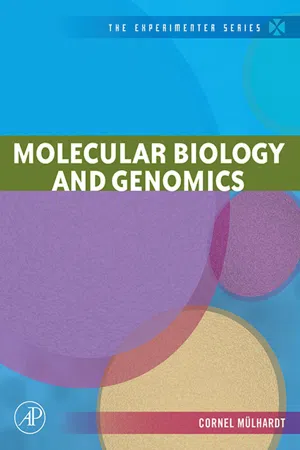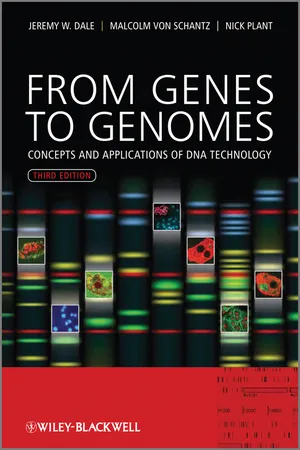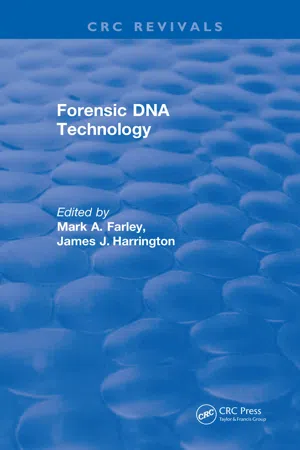Biological Sciences
Polymerase Chain Reaction
Polymerase Chain Reaction (PCR) is a technique used to amplify a specific segment of DNA. It involves a series of temperature-controlled cycles that result in the exponential replication of the target DNA region. PCR is widely used in biological research, medical diagnostics, forensic analysis, and other fields to produce large quantities of DNA for analysis.
Written by Perlego with AI-assistance
Related key terms
Related key terms
1 of 4
Related key terms
1 of 3
11 Key excerpts on "Polymerase Chain Reaction"
- eBook - ePub
Calculations for Molecular Biology and Biotechnology
A Guide to Mathematics in the Laboratory
- Frank H. Stephenson(Author)
- 2004(Publication Date)
- Academic Press(Publisher)
8The Polymerase Chain Reaction
Introduction
The Polymerase Chain Reaction (PCR) is a method for the amplification of a specific segment of nucleic acid.* A typical PCR reaction contains a template nucleic acid (DNA or RNA), a thermally stable DNA polymerase, the four deoxynucleoside triphosphates (dNTPs), magnesium, oligonucleotide primers, and a buffer. Three steps are involved in the amplification process. (1) In a denaturation step, the template nucleic acid is made single-stranded by exposure to an elevated temperature (92–98°C). (2) The temperature of the reaction is then brought to between 65°C and 72°C in an annealing step by which the two primers attach to opposite strands of the denatured template such that their 3′ ends are directed toward each other. (3) In the final step, called extension , a thermally stable DNA polymerase adds dNTPs onto the 3′ ends of the two annealed primers such that strand replication occurs across the area between and including the primer annealing sites. These steps make up one cycle and are repeated over and over again for, depending on the specific application, from 25 to 40 times.A very powerful technique, PCR has found use in a wide range of applications. To cite only a few, it is used to examine biological evidence in forensic cases, to identify contaminating microorganisms in food, to diagnose genetic diseases, and to map genes to specific chromosome segments.Template and Amplification
One of the reasons the PCR technique has found such wide use is that only very little starting template DNA is required for amplification. In forensic applications, for example, a result can be obtained from the DNA recovered from a single hair or from residual saliva on a licked envelope. Typical PCR reactions performed in forensic analysis use from only 0.5 to 10 ng of DNA.Problem 8.1 - eBook - ePub
Molecular Biology
Academic Cell Update Edition
- David P. Clark(Author)
- 2012(Publication Date)
- Academic Cell(Publisher)
CH 23 The Polymerase Chain ReactionSummary
The Polymerase Chain Reaction (PCR) is one of the most diverse techniques in molecular biology. The fundamental idea behind this technique is the ability to take a small amount of template DNA and amplify that into large amounts using repeated cycles of strand separation (dena-turation) and replication. PCR amplifies a target sequence which may be one gene from an entire genome, one gene from a recombinant plasmid, or simply one small region of a gene. To do a PCR reaction, the original DNA or target DNA must be mixed with two PCR primers (these anneal to the ends of the target, and provide a 3′-OH for which DNA polymerase to start adding nucleotides. In addition, the reaction has a DNA polymerase from Thermus aquaticus called Taq polymerase that is able to withstand high temperatures without denaturing and a supply of nucleotides. The reactions occur in a PCR machine or thermocycler that can change temperatures rapidly. The PCR reaction starts at a high temperature (90°C or more) to denature the double-stranded template DNA into single-strands, next the temperature is lowered to between 50°C and 60°C to allow each of the PCR primers to bind to the ends of the target DNA, and finally the temperature is raised to 72°C which is the optimal temperature for Taq DNA polymerase to synthesize the second strand. Each temperature is held for only 30 seconds to a few minutes, and then the three are repeated multiple times. What happens during PCR is difficult to visualize, but the first step turns the one target sequence into two, the next round turns these two sequences into four, and the next turns the four into eight, and these rounds continue increasing the amount of target DNA exponentially.Primers are an important reagent in PCR because they determine the specificity of the reaction. The traditional PCR reaction uses two primers, one anneals to the 5′ end of the non-coding strand, and the other anneals to the 3′ end of the coding strand. They both provide a 3′-OH for Taq polymerase to start adding nucleotides. The locations where the two primers anneal determine what sequence is amplified, so some sequence information has to be known. Sometimes, only a protein sequence is known, so degenerate primers are made by deducing the nucleotide code from the amino acid code. Since more than one triplet nucleotide can encode one amino acid, degenerate primers have a mixture of different bases at the wobble or third position of the triplet codons. That way, one of the primers will find a nucleotide match to the DNA sequence. In other cases, PCR primers can be designed to add two unique restriction enzyme sites to the end of the PCR products. Since the 3′ end of the PCR primer is most important, the 5′ end does not have to anneal to the target DNA, and therefore can have sequences like restriction enzyme sites that do not form hybrid DNA with the target sequence. - eBook - ePub
Genetic Engineering
Volume 1: Principles Mechanism, and Expression
- Tariq Ahmad Bhat, Jameel M. Al-Khayri, Tariq Ahmad Bhat, Jameel M. Al-Khayri(Authors)
- 2023(Publication Date)
- Apple Academic Press(Publisher)
Chapter 6 Polymerase Chain Reaction ASIMA TAYYEB and ZHUHA BASIT School of Biological Sciences, University of the Punjab, Lahore, PakistanABSTRACT
Polymerase Chain Reaction (PCR) is a remarkable technique which can be used for amplification of DNA at exponential rate. It was invented in 1983 by Mullis. In the history of biological and medical sciences, the development of the PCR has been a turning point. PCR with its ability to amplify even a single molecule makes it a highly sensitive and qualitative technique. PCR has wide range of applications in the fields of molecular genetics, systematics, epidemiology, archaeology, anthropology, evolutionary genetics, and other branches of forensic sciences. Moreover, DNA amplified through PCR can be employed in number of processes like cloning, sequencing, sizing and analytical detection (Arnheim & Erlich, 1992 ).________________________________ Genetic Engineering, Volume 1: Principles, Mechanism, and Expression. Tariq Ahmad Bhat & Jameel M. Al-Khayri (Eds.) © 2023 Apple Academic Press, Inc. Co-published with CRC Press (Taylor & Francis)6.1 History
The credit of invention of remarkable PCR in method 1983 goes to Kary Mullis, who was later on awarded with Nobel Prize in Chemistry for his invention in 1985 which he shared with Michael Smith. Techniques which were quite similar to PCR were in use in past, but a major breakthrough in this field occurred with the discovery of Taq polymerase in 1976, which opened new avenues and provided opportunity for utilization of thermocycler which could be programmed (Mullis and Faloona, 1987 ). Taq polymerase has been derived from bacterium Thermus aquaticus, which are thermophilic and live at extreme hot temperature. One of main characteristic of this enzyme is that is remains active even beyond the denaturation temperature which makes it much effective and ends up the need to add enzyme at every new cycle (Chamberlain et al., 1994 ). - eBook - ePub
- Morteza Jalali, Francesca Yvonne Louise Saldanha, Mehdi Jalali(Authors)
- 2017(Publication Date)
- Academic Press(Publisher)
Chapter 1The Polymerase Chain Reaction
PCR, qPCR, and RT-PCR
Mehdi Jalali1 , Justyna Zaborowska2 and Morteza Jalali2 ,1 University of Liverpool, Liverpool, United Kingdom,2 University of Oxford, Oxford, United KingdomAbstract
The Polymerase Chain Reaction (PCR) is a laboratory technique used for the amplification of a specific DNA fragment in a simple enzyme reaction. The basic PCR method has been modified to expand its application. Development of quantitative PCR (qPCR) has enabled detection and quantification of the target sequence in real time, while it is being synthesized. Another popular variation is reverse transcription Polymerase Chain Reaction (RT-PCR), a technique used to detect and measure RNA. PCR technology has revolutionized the field of molecular biology and medical research. Because of its widespread use, it is important to understand the scientific principles of PCR. The aim of this chapter is to explain the concepts underlying this method and to explore the clinical usefulness and potential of this technique. The chapter also provides detailed protocols on how to undertake PCR in the laboratory, including techniques for RNA isolation, cDNA synthesis, and data analysis. A scenario in which PCR is utilized to answer a research question is also described, as well as guidance on how to troubleshoot experimental problems. - eBook - ePub
- David P. Clark(Author)
- 2009(Publication Date)
- Academic Cell(Publisher)
Chapter Twenty - Three
The Polymerase Chain Reaction
Fundamentals of the Polymerase Chain Reaction Cycling Through the PCR Degenerate Primers Inverse PCR Adding Artificial Restriction Sites TA Cloning by PCR Randomly Amplified Polymorphic DNA (RAPD) Reverse Transcriptase PCR Differential Display PCR Rapid Amplification of cDNA Ends (RACE) PCR in Genetic Engineering Directed Mutagenesis Engineering Deletions and Insertions by PCR Use of PCR in Medical Diagnosis Environmental Analysis by PCR Rescuing DNA from Extinct Life Forms by PCR Realtime Fluorescent PCR Inclusion of Molecular Beacons in PCR-Scorpion Primers Rolling Circle Amplification Technology (RCAT)Fundamentals of the Polymerase Chain Reaction
Of all the technical advances in modern molecular biology, the Polymerase Chain Reaction (PCR) is one of the most useful. The PCR provides a means of amplifying DNA sequences. Starting with incredibly tiny amounts of any particular DNA molecule, the PCR can be used to generate microgram quantities of DNA. PCR is sufficiently sensitive that it can amplify the DNA from a single cell into amounts sufficient for cloning or sequencing. Consequently, PCR is used in clinical diagnosis, genetic analysis, genetic engineering and forensic analysis. In particular, PCR has revolutionized and speeded up the whole area of recombinant DNA technology. Previously, cloned DNA was made by growing up bacterial cultures and extracting and purifying the DNA. PCR allows the rapid generation of large amounts of specific DNA sequences that are easier to purify and less damaged. In this chapter we will examine how the Polymerase Chain Reaction works. As the name indicates, DNA polymerase is used to manufacture DNA using a pre-existing DNA molecule as template. Each new DNA molecule synthesized becomes a template for generating more, thus creating a chain reaction. The PCR actually amplifies only a chosen segment (the target sequence ) within the original DNA template, not the whole template DNA molecule (Fig. 23.01 - eBook - ePub
- George P. Patrinos, Wilhelm Ansorge, Phillip B. Danielson(Authors)
- 2016(Publication Date)
- Academic Press(Publisher)
Chapter 4Quantitative Polymerase Chain Reaction
L. Overbergh, S. Vig, F. Coun, and C. Mathieu KU Leuven, Leuven, BelgiumAbstract
The Polymerase Chain Reaction (PCR) is a technology used to exponentially amplify a short, specific DNA region of interest, generating thousands to millions of copies of this specific region, all with a similar sequence and length. It is one of the few techniques that has undoubtedly revolutionized the field of molecular biology and diagnostics. Since the invention of the classical end-point PCR in 1986, the technique has gone through a revolutionary period, with a boost in 1992 due to the invention of real-time or quantitative PCR (qPCR), which allowed for monitoring the PCR reaction in real-time, thereby making the quantification of nucleic acids much more simple, accurate, and sensitive. It is a key technology that is present on almost every bench in a research or diagnostic laboratory. In this chapter we will give an overview of the qPCR technique, starting from its invention, describing the different methodologies and important factors to be taken into account when optimizing and using this widespread nucleic acid-based technique.Keywords
Quantitative PCR; Real-time PCR; Reversion transcription quantitative PCR4.1. History of the Polymerase Chain Reaction
The Polymerase Chain Reaction (PCR) is a technique based on the exponential amplification of nucleic acids by the thermostable Thermus aquaticus (Taq ) polymerase. The method uses a pair of synthetic oligonucleotide primers, each hybridizing to one strand of a double-stranded DNA (dsDNA) target of interest, with the pair spanning a region that will be exponentially amplified. The annealed primers act as a substrate for the Taq DNA polymerase, creating a complementary DNA strand via the sequential addition of deoxynucleotides (dNTPs), which have been added to the reaction mixture (Fig. 4.1 ). Experimentally, the process most typically consists of three steps:1. a denaturation step at 94 or 95°C, - eBook - ePub
An Introduction to Biotechnology
The Science, Technology and Medical Applications
- W.T. Godbey(Author)
- 2014(Publication Date)
- Academic Press(Publisher)
Chapter 11The Polymerase Chain Reaction
Abstract
At this point in the text, we are headed toward producing our own gene sequences. However, a single copy of a DNA sequence is seldom (if ever) enough for the biotechnologist to work with. PCR is a means by which exponential numbers of a given DNA sequence are produced from minimal quantities of starting material. PCR is used to indicate the transcriptional activity of a specific gene (which can, for example, imply drug bioactivity), to help identify cell type or human identity, or to generate sufficient starting material for molecular cloning.The rudiments of the PCR process will be described, and then different uses of the chain reaction will be presented to compare and contrast traditional and real-time PCR. Mechanisms of qPCR that use SYBR green and primer/probe sets will be discussed.Keywords Amplicon Melt Anneal Extend PCR loops Cycle number Transcriptome Internal control Primer dimer Background fluorescence qPCRCycle threshold (Ct)Delta-deltaTraditional and real-time PCR SYBR green Primer Primer efficiency ProbeCt(2− ΔΔ )DNA polymerase, which we have already discussed in terms of cellular replication, can be used in the laboratory to make multiple copies of a DNA fragment. While the cell will use DNA polymerase to make a single copy of its genome before division, in the laboratory, we can use the polymerase repeatedly to amplify a region of DNA (called an amplicon ) at an exponential rate. In the first round of amplification, the amplicon will be replicated once. In the second round, the amplicons of the original DNA and the copies made during the first round will be replicated. In the third round, the amplicon and all of the previously constructed copies (a total of four dsDNA molecules) will be replicated, leaving us with a total of eight dsDNA fragments at the end of the round. These rounds of replication will continue, ultimately yielding (by one theory) 2n - eBook - ePub
- Cornel Mulhardt(Author)
- 2010(Publication Date)
- Academic Press(Publisher)
4The Polymerase Chain Reaction
Publisher Summary
A typical polymerase-chain-reaction (PCR) program consists of a denaturing step, an annealing step, and an extension step. The requirements for a PCR are a thermostable deoxyribonucleic acid (DNA) polymerase, a small amount of initial DNA (template), and two suitable oligonucleotide primers. The reaction begins after adding buffers and nucleotides to this and placing the tube in a PCR machine. Denaturing, whereby the two strands of the DNA template are separated from one another, is carried out at 94°C. The temperature is subsequently lowered to 55°C so that a hybridization of the oligonucleotide primer, which is available in massive excess, is carried out on the single-stranded DNA template. After that, the temperature is increased to 72°C, the optimal temperature for Taq polymerase. The primer is thereby elongated until a double-stranded DNA is formed, which is exactly equivalent to the original DNA template. Because complementation occurs along both strands of the DNA template, the number of template DNA is doubled in the course of one cycle. If this cycle is repeated, the experimenter obtains a fourfold quantity. By means of nested PCR, extremely small quantities of template can be demonstrated. This method allows the amplification of almost every complementary DNA (cDNA) from any desirable tissue. The uses of PCR appear to be endless—at least there does not seem to be any end to this ingenuity at present.Heil dem Wasser! Heil dem Feuer! Heil dem seltnen Abenteuer! Safely the water! Safely the fire! Safely the rare adventure!The Polymerase Chain Reaction (PCR) should be found in the chapter on tools. However, it is the method of choice in molecular biology, which is reason enough to dedicate a chapter to this subject alone.The principle is wonderfully simple, and it is reasonable to ask why it was discovered long ago (Figure 4-1 - eBook - ePub
From Genes to Genomes
Concepts and Applications of DNA Technology
- Jeremy W. Dale, Malcolm von Schantz, Nicholas Plant(Authors)
- 2011(Publication Date)
- Wiley(Publisher)
4 Polymerase Chain Reaction (PCR)On 10 December 1993, Kary B. Mullis received the Nobel Prize in Chemistry from King Carl XVI Gustaf of Sweden for the invention of the Polymerase Chain Reaction (PCR) method. Mullis had published and patented this invention only eight years earlier, in 1985. The same year, the Physiology and Medicine prize was awarded to Richard J. Roberts and Phillip A. Sharp, for their independent discovery that eukaryotic genes are composed of introns and exons. These laureates had waited twice as long, 16 years, since their fundamental discovery made in 1977. When you consider how fundamental the idea of introns and exons is to eukaryotic genetics, you gain some idea of the immense impact PCR has had, when its discovery was so quickly honoured. Although it is (as we shall see) quite a simple method with obvious limitations, the applications have revolutionized both basic and applied biology. This has been particularly dramatically illustrated in forensic science, where old open cases have been solved due to the ability to gain information from small amounts of trace evidence, and in clinical applications, where it has suddenly become possible to make in hours diagnoses that previously took weeks.In essence, PCR serves but one function, which is to amplify a relatively short segment of DNA many times, even if it initially forms only a minute part of a very complex mixture. As we will see below, this procedure requires subjecting the sample to a cycle of defined temperature steps, including heating to 95°C. The key factor in transforming the initial PCR method into one that could be undertaken in thousands of laboratories worldwide, and that has such an important impact in many areas, was the use of a thermostable DNA polymerase called Taq polymerase. It was originally isolated from Thermophilus aquaticus , a thermophilic archaean that thrives in hot springs at temperatures close to the boiling point of water. As a result, all enzymes in this organism have evolved to withstand high temperatures at which most proteins from most other organisms would denature immediately and irreversibly. Hence Taq polymerase can survive the repeated high temperatures required by the PCR without significant loss of activity. Apart from this distinct feature, Taq polymerase (not to be confused with Taq I, a restriction enzyme from the same species) is a normal DNA polymerase, which is able to synthesize a new DNA strand complementary to a single-stranded DNA template. Like all other DNA polymerases, it requires a primer - eBook - ePub
- Mark A. Farley(Author)
- 2019(Publication Date)
- CRC Press(Publisher)
Although PCR is a relatively young technology—it was first described in 1985 2 —it has rapidly gained acceptance as a tool in molecular biology, population genetics, and medical diagnostics (see, for example, ref. 3) and is emerging as the cornerstone technology in the human genome mapping project. Two features of PCR are of obvious benefit to the analysis of biological evidence. First, amplification is possible from very small amounts of DNA, as little as the DNA in a single cell. 4 This allows genetic information to be obtained from evidence samples that contain insufficient cellular material for other genetic typing approaches, e.g., single shed hairs. 5 Second, amplification is possible from degraded DNA; 6 the DNA in a significant proportion of biological evidence is degraded. From an operational standpoint, PCR offers two additional benefits: it is relatively simple to perform and results can be obtained within a short time frame, usually within 24 hours. 7 These advantages ensure a prominent role for PCR in the future of forensic DNA analysis. The objective of this chapter is to describe how PCR works, how it can be used for the detection of genetic variants, and how it meets the criteria for application in the forensic context. Gene Amplification by the Polymerase Chain Reaction PCR was conceived and first developed by Mullís et al. 2, 8 at Cetus Corporation. The concept is strikingly simple (Figure 1); indeed, it is analogous to the replication process used by cells to replicate their own DNA. Two short oligonucleotides are hybridized to the opposite strands of a target DNA segment in positions flanking the sequence region of interest; these two oligonucleotides are oriented such that their 3’ ends point toward each other. The two oligonucleotides prime an enzyme-mediated replication of the complementary DNA strand; they extend off their 3’ end using the target sequence as the template for replication - eBook - ePub
- William Goodwin, Adrian Linacre, Sibte Hadi(Authors)
- 2011(Publication Date)
- Wiley(Publisher)
5 Polymerase Chain ReactionIn 1985 a new method – the Polymerase Chain Reaction (PCR) – was reported [1–3]. PCR can amplify a specific region of DNA by copying the locus exponentially. The method has revolutionized all areas of molecular biology, including forensic genetics, as extremely small quantities of DNA can be analysed. Under optimal conditions, DNA can be amplified from a single cell [4, 5]. The increased sensitivity of DNA profiling using PCR has had a dramatic effect on the types of forensic sample that can be used, and it is now possible to analyse trace evidence and highly degraded samples successfully – albeit with less than 100% success.The evolution of PCR-based profiling in forensic geneticsPCR technology was rapidly incorporated into forensic analysis. The first PCR-based tool for forensic casework amplified the polymorphic HLA-DQα locus (the α subunit of the DQ protein is part of the major histocompatibility complex) [6]. It was used for the first time in casework in 1988 to analyse the skeletal remains of a 3-year-old girl [7, 8]. The DQα system’s major drawback was that it had a limited power of discrimination.Minisatellites (VNTRs) were widely used in casework but required a relatively large amount of DNA. In an attempt to overcome this limitation, PCR technology was applied to the analysis of VNTR loci, and alleles between 5 kb and 10 kb could be faithfully amplified from fresh biological material [9]. However, it was of limited value for many forensic samples, which often contained small amounts of DNA that was highly degraded. To overcome the problems caused by degradation, tandem repeats, called amplified fragment length polymorphisms (AMP-FLPs) that were smaller than 1kb were selected for PCR based analysis [10–15]. However, as with VNTRs, their use was limited in forensic contexts because of the size of the larger alleles, which were difficult to analyse in degraded samples. By the early 1990s, a large number of STRs had been characterized [16]. The STR loci were simpler and shorter than VNTRs and AMP-FLPs, and were more suitable for the analysis of biological samples recovered from crime scenes [17]. The STR markers were not individually as discriminating as the VNTR and AMP-FLPs, but had a major advantage that several of them could be analysed together in a multiplex reaction. The STR markers have become the genetic polymorphism of choice in forensic genetics and PCR is a vital part of the analytical process.
Index pages curate the most relevant extracts from our library of academic textbooks. They’ve been created using an in-house natural language model (NLM), each adding context and meaning to key research topics.
Explore more topic indexes
Explore more topic indexes
1 of 6
Explore more topic indexes
1 of 4
